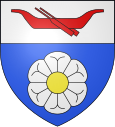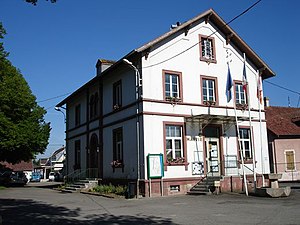Rosenau (Haut-Rhin)
| Rosenau | ||
|---|---|---|

|
|
|
| region | Grand Est | |
| Department | Haut-Rhin | |
| Arrondissement | Mulhouse | |
| Canton | Saint-Louis | |
| Community association | Saint-Louis agglomeration | |
| Coordinates | 47 ° 38 ' N , 7 ° 32' E | |
| height | 226-247 m | |
| surface | 6.47 km 2 | |
| Residents | 2,374 (January 1, 2017) | |
| Population density | 367 inhabitants / km 2 | |
| Post Code | 68128 | |
| INSEE code | 68286 | |
| Website | www.rosenau.fr/cms/ | |
 The parish hall of Rosenau |
||
Rosenau (Alsatian Rosenöi ) is a French commune with 2374 inhabitants (as of January 1, 2017) in the canton of Saint-Louis in the Haut-Rhin department in the Grand Est region (until 2015 Alsace ).
geography
The village is about 10 kilometers from the cities of Saint-Louis , Weil am Rhein ( Germany ) and Basel ( Switzerland ). It belongs to the agglomeration of Basel. In the north the community borders on Kembs , in the west on Bartenheim and Blotzheim and in the south on Village-Neuf . The Rhine forms the eastern border.
The majority of the community lies between the Rhine side canal and the Canal de Huningue . Due to its geographical location, part of the Réserve Naturelle de l'Île du Rhin belongs to the municipality. Rosenau also borders the Petite Camargue Alsacienne nature reserve and the Isteiner thresholds to the east .
history
Until the Peace of Westphalia (1648), parts of the area of today's municipality and the neighboring Alsatian communities belonged to the Upper Austrian provincial bailiffs of Oberelsaß and Sundgau, namely to the upper office of the Landser lordship . In the Peace of Westphalia, the Habsburgs ceded their possessions in Alsace to the Kingdom of France , making the Upper Rhine also an imperial border - precisely the valley path of the Rhine. The definition of the district boundaries followed different criteria and the Rhine changed its course with every flood and often had a different valley path afterwards, i.e. H. the national border changed, while the municipal boundaries at most continued to exist. As a result, the state borders did not coincide with the district boundaries, which of course led to additional points of contention between the states and municipalities.
The Rheininsel Rosenau (also Owe or Rosenowe ) was originally the southernmost island that was under the spell of the municipality of Istein . In the 17th century, the valley path of the Rhine slowly shifted eastwards to the Isteiner Klotz , which turned numerous Rhine islands - and Rosenau too - into islands on the left bank of the Rhine . The various islands were used as pasture and for logging.
The area of today's French community of Rosenau originally belonged mainly to the German communities of Istein , Efringen , Kirchen , Huttingen on the right bank of the Rhine . The settlement took place only in the 18th century by citizens of Istein and Huttingen . After only one mill had been built in 1691, the actual settlement followed from 1728. Around 1768 the influx from Istein and Huttingen stalled and more settlers came from the Alsatian Sundgau; Since the middle of the 18th century, the Istein branch community of Rosenau sought to separate from Istein, which then took place in 1791. The new community initially had 62 inhabitants and in 1794 received Johann Streich as its first mayor. In terms of church, Rosenau now joined Village-Neuf as a branch until it received its own church in 1871. Subsequently, the village shared the fate of Alsace (1871-1919 belonging to the German Empire) and had to bear additional burdens due to its proximity to the Hüningen fortress .
coat of arms
The coat of arms of Rosenau shows the silver flower of the white water lily with golden stamens in blue below . Above in silver a red willow with two red oars.
The coat of arms alludes to a version of the name interpretation, namely that the name Rosenau is derived from the water lilies growing in the still waters of the Rhine at that time. Another, more tangible interpretation is that the Rosenau is the meadow on which the horses were grazed. In particular, it is assumed that the grazing rights that the residents of the neighboring municipality of Bartenheim had for their horses and cows led to the naming. The Weidling is an ancient type of boat that was also used by the fishermen on the Upper Rhine.
Population development
| year | 1962 | 1968 | 1975 | 1982 | 1990 | 1999 | 2007 | 2016 |
| Residents | 619 | 673 | 1,031 | 1,591 | 1,501 | 1,841 | 1,988 | 2,349 |
Community partnerships
Partnerships exist with Efringen-Kirchen , district Istein on the opposite bank of the Rhine and with the French communities Savigneux , Bougue , Mazerolles and Laglorieuse .
literature
- Fritz Schülin: The Isteiner daughter settlement Rosenau . In: Fritz Schülin, Hermann Schäfer, Pius Schwanz: Istein and the Isteiner Klotz , 3rd edition 1994, pp. 196–202
- Pius Schwanz: The final solution to the Rosenau conflict . In: Fritz Schülin, Hermann Schäfer, Pius Schwanz: Istein and the Isteiner Klotz , 3rd edition 1994, pp. 653–654
- Viktor August Krust: Rosenau and its surroundings . In: Yearbook of the Sundgau Association 1940–1942, pp. 51–73
- Société d`histoire de Bartenheim: Rosenau, Fille du Rhin . Editions Coprur, Strasbourg 1992, ISBN 2-903297-74-6 (French)
- Fritz Schülin: The Rosenau. In: Markgräfler Jahrbuch 1939, pp. 60–66, digitized version of the Freiburg University Library
Web links
Individual evidence
- ↑ The Thalweg the Rhine is the most appropriate during the ordinary lowest water level for Thal navigation path ; s. State treaty of the Grand Duchy of Baden with the Kingdom of France for the correction of the Rhine borders and the establishment of property and acquisitions with regard to the Rhine islands of November 29, 1827; Grossherzoglich-Badisches Staats- und Regierungs-Blatt, Volume 25, No. XXIII of December 10, 1827, pp. 263–268 in the Google book search
- ↑ A good impression of the Rhine landscape at that time is given by the picture by Peter Birmann [1]
- ↑ The cattle were brought to the islands with Weidlingen
- ↑ s. Schülin p. 201
- ↑ s. wiktionary Ross
- ↑ s. Schülin p. 197

